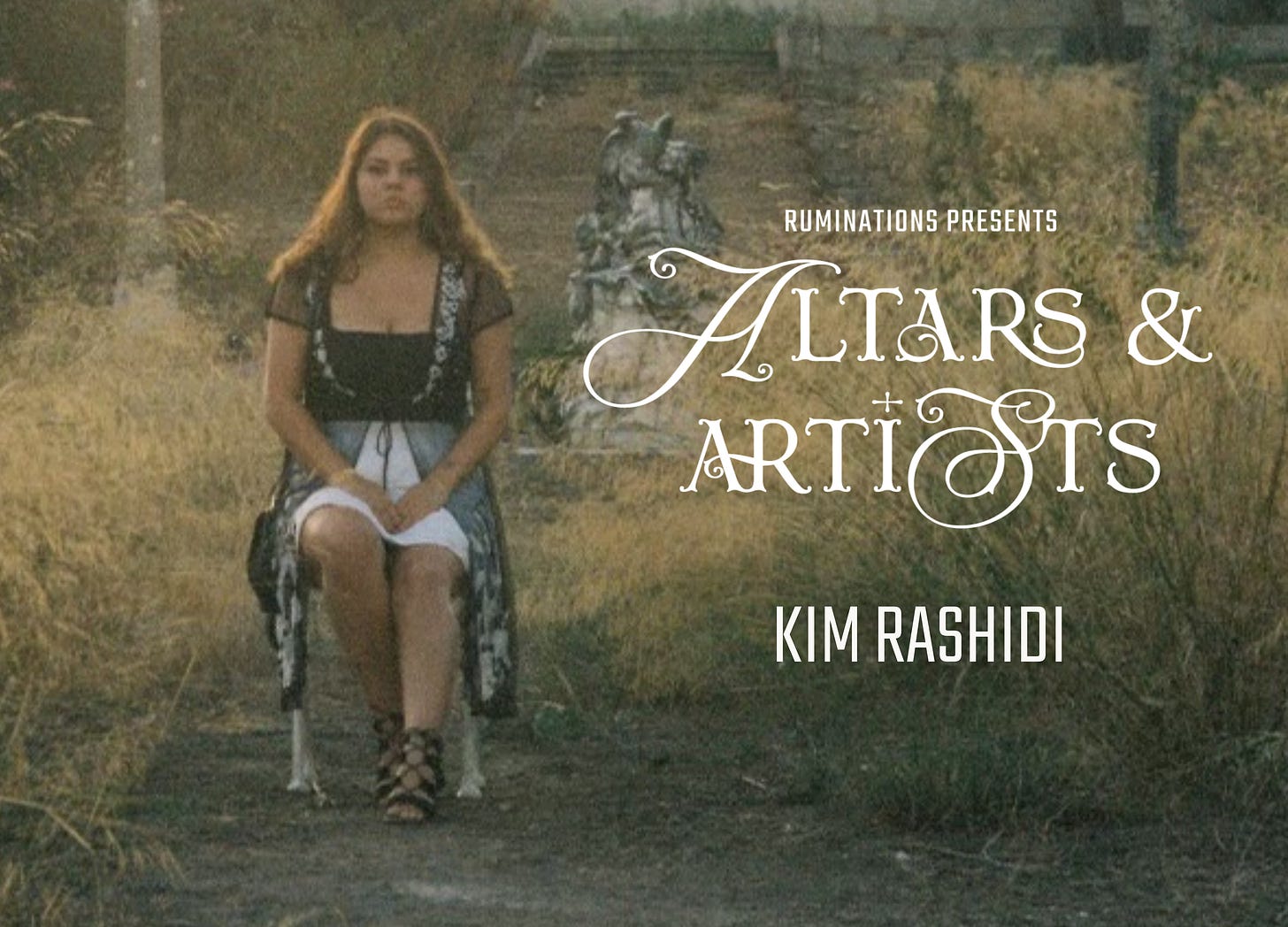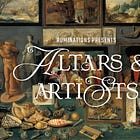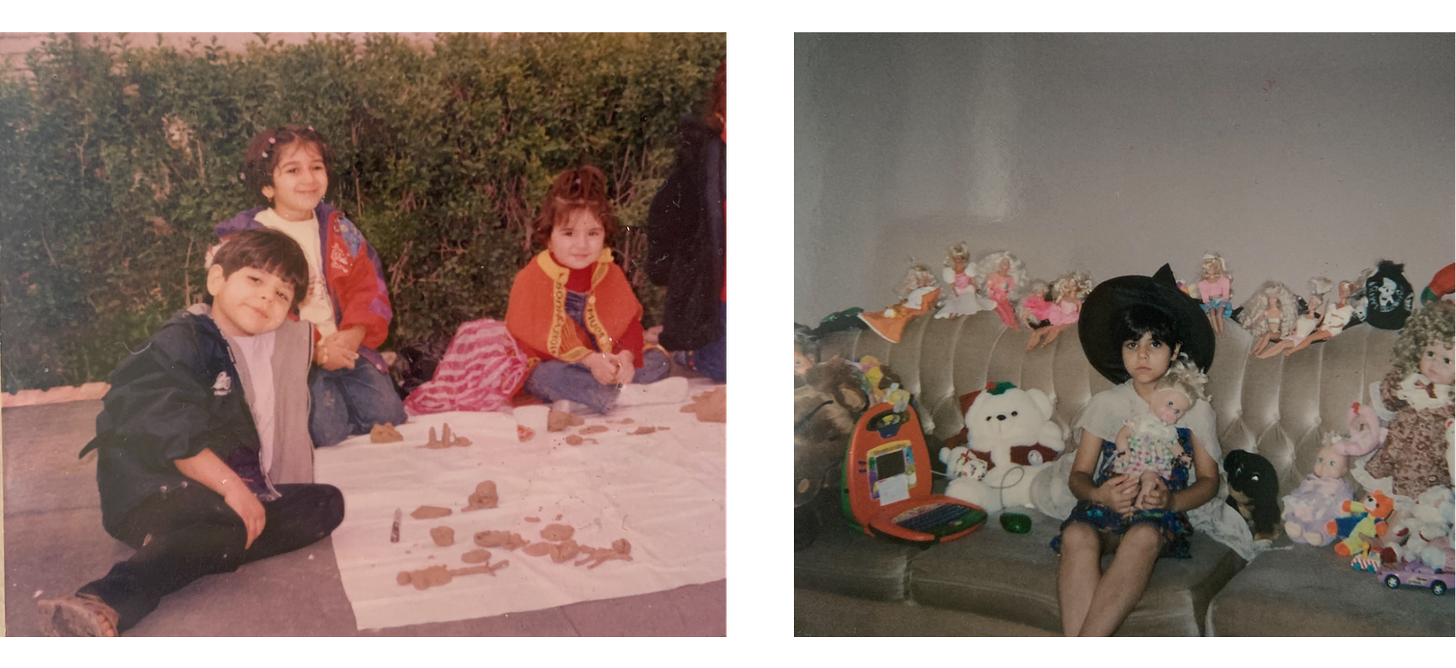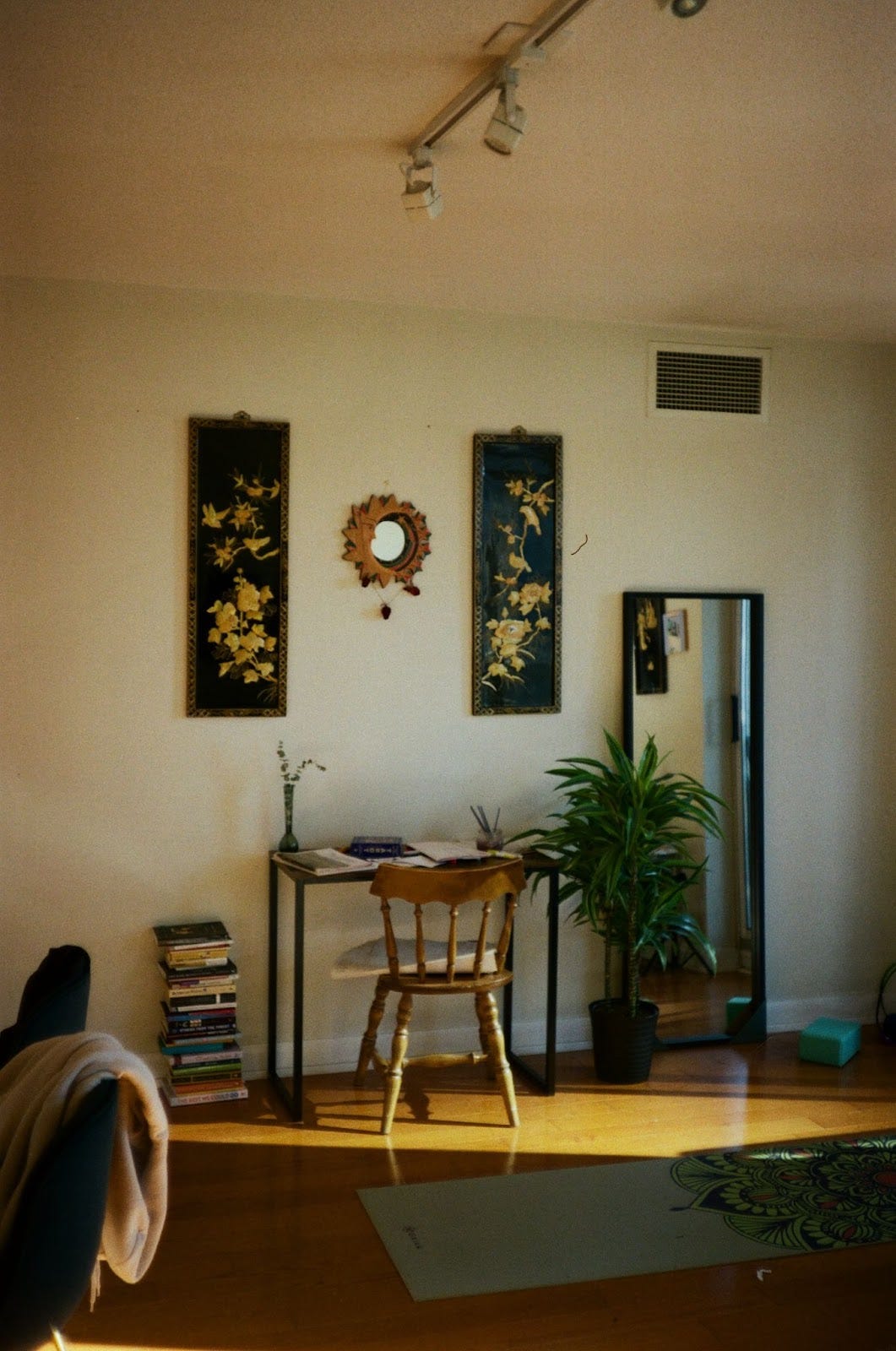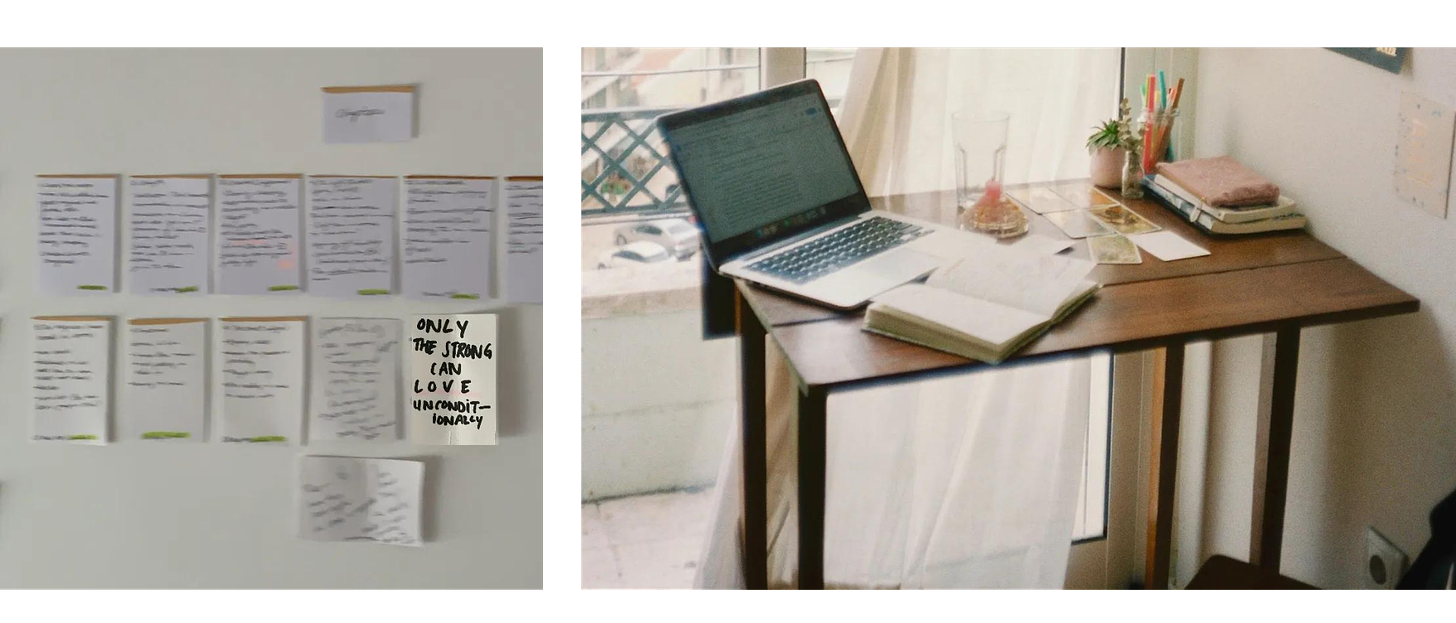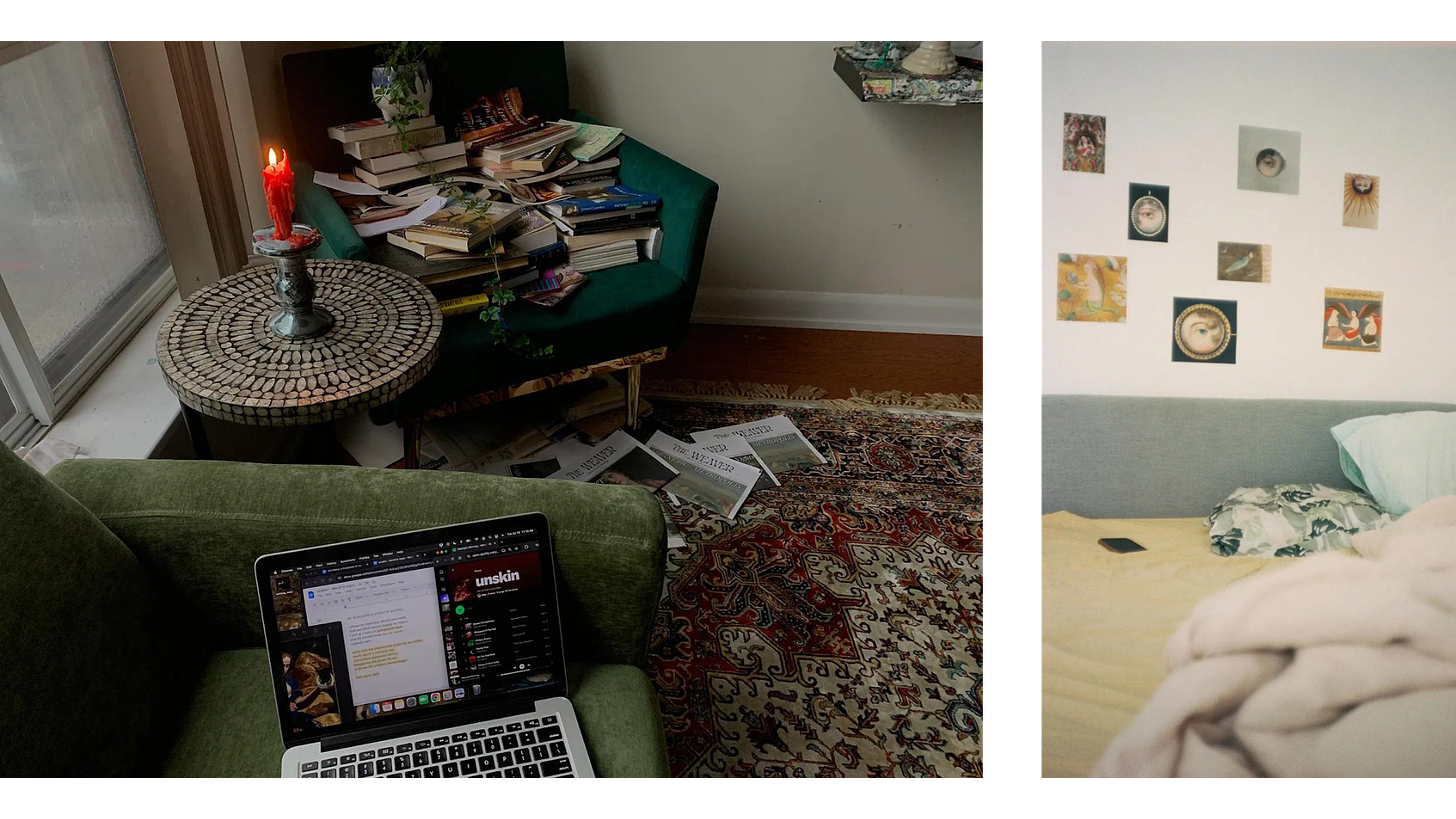Altars & Artists: Kim Rashidi
Interview 01 - peculiarities, Persian rugs, and "Inferno, but for the girls"
Welcome to Altars & Artists, a monthly interview series divining the poetry of artists' spaces. Inspired by Gaston Bachelard’s book "The Poetics of Space" and Virginia Woolf’s extended essay "A Room of One’s Own", Altars & Artists delves into the creative spaces of contemporary artists to reveal the intimate worlds they operate within.
If you enjoy this series, please consider becoming a paid subscriber—doing so unlocks an extended cut of each interview, including a prompt made especially for you by the guest. Your contribution also keeps Ruminations running & this writer at her desk ❧
New to this series? Be sure to check out the intro post below:
Please welcome our first guest to Altars & Artists—Kim Rashidi ❧
Kim Rashidi (she/her) is a Toronto-based novelist, poet, and weaver of sensory mythologies. Kim’s curiosity is unbounded—already at twenty-something, she is the author of two books (Only Alive On Sundays and Fortunate) and the artistic director behind the print literary magazine The Weaver.
After initially meeting through a writing group, I am now lucky enough to call Kimmy a friend. Her passion for the arts and zeal for the written word is contagious, so inviting her to collaborate with me on the first interview of this series was a no-brainer. I hope you enjoy our conversation as much as I did <3
Questions & Curiosities
Welcome to Ruminations, Kimmy, it’s such a pleasure to have you here! Tell us a little about yourself and your art form. What things do you enjoy exploring through the creative process?
Hi! An honour to be the first guest. The official spiel is that I am a Toronto-based writer with a soft spot for capturing the magic of the mundane. Writing about the lives, cities, and timelines that mirror back the romantic, I love to weave reality with imagined possibilities. But on a more intimate level, I’m very interested in creativity as a means of resolving unconscious matter or exploring the collective unconscious. My gateway into that intersection started on a much lighter note via Tarot. I am the author of two books creatively inspired by tarot cards: Fortunate: Tarot Poetry and Only Alive on Sundays: A Novella. The creative process for me, at this point in time, is all about the etheric origins of ideas and creativity itself.
I could not continue this interview without acknowledging you as one of my inspirations for this series! After contributing to The Weaver’s debut issue, Accidental Altars, I feel as though I’ve begun imbuing a sense of reverence into the way I interact with the world around me. In your opening essay to Accidental Altars, you declare, “A desk is no longer a workspace—it is my altar, where I come to relinquish control over stories bred into me.” What does the word “altar” mean to you, and what led you to invoke it in your craft?
I’m really glad our work on that issue inspired such a beautiful new series on Ruminations!
As a personal ethos (or maybe this is my five Aquarius placements speaking), I love to be light-hearted with heavy words. Not too precious with the ones that evoke traditionally gate-kept concepts. And this is why I love the term accidental altars—it gives us a chance to play with what an Altar might be and how serious it’s perceived to be. At its core, an Altar is an intentional space of worship. But, an accidental altar only recognizes the ritual of worship after the objects of the altar have been gathered. Because I take a mostly animistic approach to life, I treat most things with reverence, so it’s easy for me to create altars out of anything. But the things I’m truly passionate about, namely writing, take a much more prominent role in altar-ship. Because I do worship the act of writing. Creating worlds of felt meaning out of thin air is worthy of worship in my opinion. I made a silly TikTok once where I said writing is ritualistic labour / my laptop is an altar / a word document my saviour, and despite how dramatic that sounds, it’s the truth.
What, then, was your first “altar”? Could you describe it for us, tell us how old you were at the time, and share what you would create there?
I have to say I got into reading and writing pretty late. As a child, I never cared much about these things that make up the entirety of my life now. What I do remember is performing. I loved to play-pretend, and not in a tea-party sense of the word, but I think I thought of myself as a little actress. So, my altars as a child were quite intangible, make-shift even. Gathering all of my toys as audience members to whatever theatrical idea I had going on was my altar. There’s also the fact that my family moved around a lot when I was growing up, so I can’t say I ever had a dedicated space that I could return to over the years. My altars had to be adaptive shape-shifters just like the roles I would take on. I loved pottery as a kid, so clay and a mat at the park was likely one of my first altars.
Let’s turn to your current creative space now! We’d love to see where all the weaving and storytelling happens.
Here is the current main space I have set up. I found this chair on the side of the street and polished it up, the desk is a random cheap one, and the gorgeous panels are a loan from my mom. It isn’t much because, like I mentioned before, my laptop is my altar. I can set it up anywhere! I feel as though the entirety of my living room is my creative space though. I tend to work quite erratically, and that’s reflected in my space. In one corner I have an arm-chair over-run by books, which I love to rummage through. Simply retrieving a book on a shelf would be in opposition to how my brain works it seems. I love working on the couch, too. Being comfortable and unstructured tends to lead to better ideation for me. I’m also a huge fan of the bedroom-floor picnic. Culturally, we Iranians love to lounge on the ground. So, my dad’s Persian rug is also where a lot of my magic happens.
How has your writing desk evolved with you as an artist? Have you changed elements of it, or moved from other spaces?
I’ve moved around a lot; I’ve only been in my current space for about a year now. So my conceptual writing desk is constantly in transit. It’s evolved with me in the sense that I’m better at setting it up depending on what I’m working on—if it’s editing, I know I’ll need a clear desk. If I’m brainstorming, I’ve got scrap paper handy. When I was in Lisbon and working on Only Alive on Sundays, my writing space consisted of my desk and the wall on which I was brainstorming. I think a wall to map out ideas is essential to any writing space.
I agree, I use my walls religiously! When not at your desk, where might one find you? Is this influenced at all by the current focus of your work or the stage of the writing process you’re in?
I think the project dictates the space I need. My current project (and my next book! Girl Mess: a Katabasis in verse) is very esoteric in nature and demanded that I keep track of my dreams and that I write while in semi-meditative states; I generally needed to be more introspective. I found the structure of a writing desk too rigid for the purposes of this book and gravitated towards more gentle spaces like a couch or my bed. I needed the softness of a bed to allow the line between unconscious matter and a writing routine to bleed into one another.
Your writing has this wonderful touch of the whimsical and mythological. Who would you say are your largest artistic influences? How do you pay tribute to them in your creative space and craft?
Conceptually, I find myself gravitating towards mystic poets in the Iranian tradition such as Rumi, Hafez, and Omar Khayyam. I adore T.S Eliot’s work for its intrepid reflections on the human condition and Forugh Farrokhzad’s, at times melancholic, expression of womanhood. Pamela Colman Smith’s approach to creativity in the occult tradition is something I find myself returning to a lot. Mary Oliver and Clarice Lispector are also writers I admire for their style and content. I think the common denominator here is that I’m inspired by artists who revere creativity as a divine thing, a force to be harnessed or played with or prayed upon. What I’ve learned from these artists is to follow (or yank on) any threads of curiosity that I come upon. There is a truth they are all trying to uncover, and so am I.
In The Poetics of Space, Bachelard explores nests as a place of retreat and security, and yet likens nests to “a swelling fruit, pressing against its limits”, thereby juxtaposing the small space with great abundance. With fruit being a recurring motif in your own work, I thought, firstly, you might enjoy the comparison, and hoped, secondly, you might share your thoughts on this idea of the creative space as an altar and nest, ripe and abundant with inspiration.
I do love this comparison! And it’s no secret that the spaces artists occupy (physically or mentally) shape their work. I think about Fernando Pessoa’s 70-something heteronyms that he wrote under—it was not enough to publish under pseudonyms, but rather as identities he felt he took on when writing as one of them. Each was an inhabited nest with its own world and limitations from which to conjure stories. I also think about Forugh Farrokhzad who wrote, “I believe that any artistic endeavor must be accompanied by awareness. Awareness of life, existence, body, even of this apple we bite into. One cannot—indeed, must not—live with instinct alone. One must form an opinion about oneself and the world and this forces the artist to think.”1 These opinions that we form about the world around us feel more like a relationship to me. Some more symbiotic than others. And we, as artists, take inspiration from these relationships. This is what it means to have an artist’s eye—an expanded sense of awareness, a ritualization of the art of noticing. To use myself as an example: bathroom tiles are significant to the story of my novella. Living in Portugal at the time, I was surrounded by gorgeous tiles everywhere. The way I saw the tiles, with reverence and appreciation, was bound to seep into my work. The world is the artist’s altar.
“This is what it means to have an artist’s eye—an expanded sense of awareness, a ritualization of the art of noticing.”
In her extended essay, Virginia Woolf argues that a woman must have “a room of her own if she is to write fiction”. As a writer yourself, how integral is solitude and autonomy over your desk space – and even the room you inhabit – to your creative practice?
I’m not going to argue with Woolf! Solitude is of essence. Space to breathe, let my guard down, think. I need the quiet to create.
Thank you so much for sharing your altars with us, Kimmy. I’m sure Ruminations’ readers would love to know what you’re up to at the moment, so I have one last question before we move on to the next segment for our paid subscribers! Is there anything you can tell us about your current projects?
This was so much fun, I appreciate any opportunity to expand on creativity. I can’t wait to share some more juicy details with your community below.
My current project is a Katabasis, an underworld journey, focusing on the trials and tribulations of girlhood. The verse-novel is a trance-like exploration of peculiar rooms and strange creatures, playing with the idea that hell is a teenage girl. I call this my Dante’s Inferno but for the girls book. This book draws on both my personal experiences in the world as a girl, but also through uncovering unconscious grey matter. Girl Mess will be out on October 8th 2024!
You can stay up to date with Kim’s work here:
Instagram: @kimrashidi
Substack:
Before you leave us with your creative prompt, we have some rapid-fire questions for you. So! Without further ado…
Keep reading with a 7-day free trial
Subscribe to Ruminations to keep reading this post and get 7 days of free access to the full post archives.






